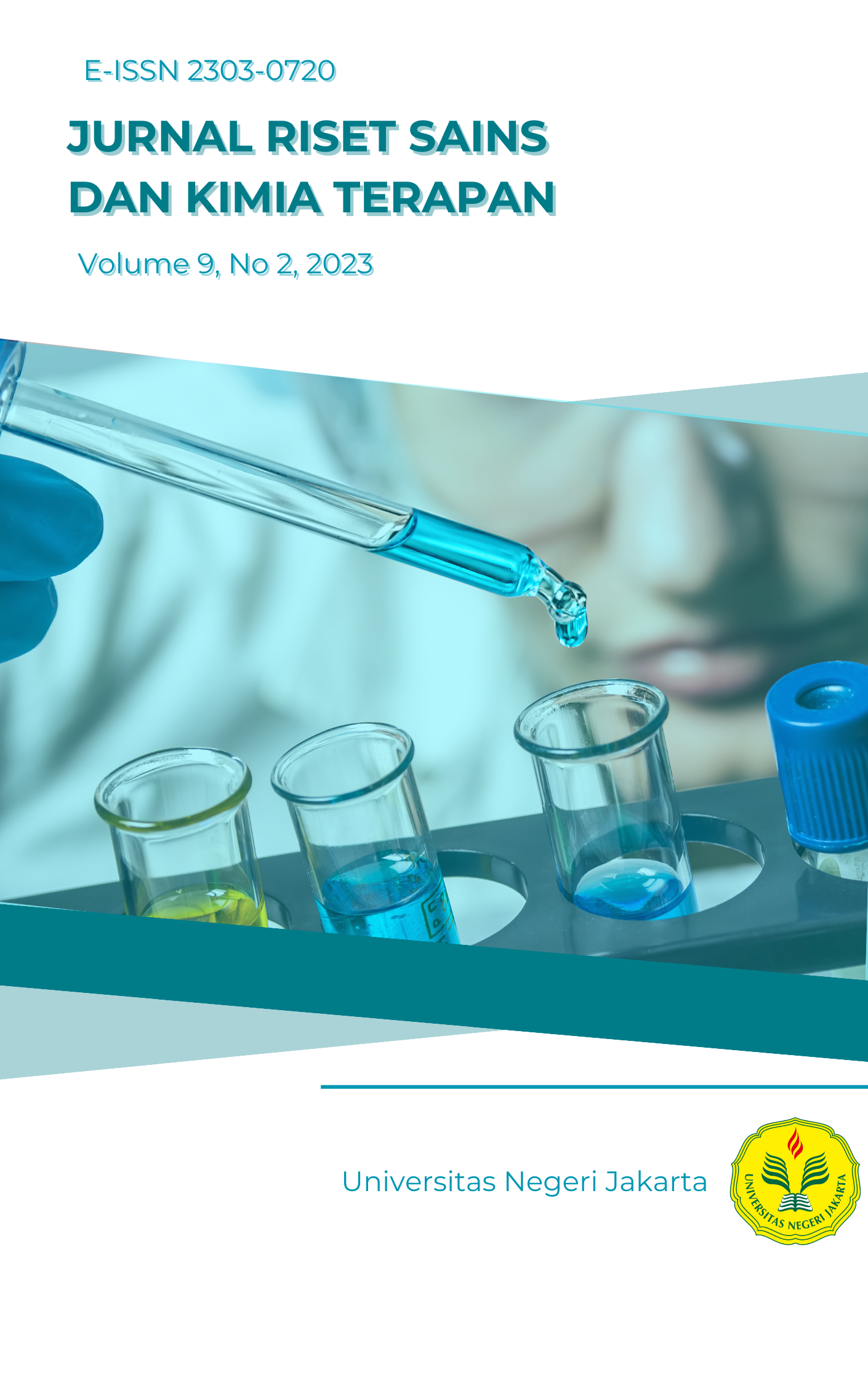Analisis Kadar Kafein dalam Sampel Kopi Instan dan Minuman Berenergi Menggunakan High Performance Liquid Chromatography (HPLC)
DOI:
https://doi.org/10.21009/JRSKT.092.04Keywords:
HPLC, kafein, kopi instan, minuman berenergiAbstract
Abstrak
Analisis kadar kafein dalam sampel menggunakan HPLC telah dilakukan. Analisis ini bertujuan untuk menentukan kadar kafein yang ada dalam sampel berupa kopi instan dan minuman berenergi serta membandingkannya dengan persyaratan SNI yang ada. Metode yang digunakan meliputi pembuatan fasa gerak, preparasi larutan standar, serta preparasi sampel. Hasil yang didapatkan ialah kadar pada sampel-1, sampel-2, dan sampel-3 berturut-turut adalah sebesar 3,24256 mg/g, 3,07105 mg/g, dan 3,1861 mg/g. sedangkan pada sampel-4 dan sampel-5 sebesar 0,14149 mg/ml dan 0,1337 mg/ml dan semua sampel masih memenuhi SNI yang ada.
Kata kunci: HPLC, kafein, , kopi instan, minuman berenergi
Abstract
Analysis of caffeine content in samples using HPLC has been carried out. This analysis aims to determine the levels of caffeine present in the samples in the form of instant coffee and energy drinks and compare them with the existing SNI requirements. The methods used include preparation of the mobile phase, standard solution preparation, and sample preparation. The results obtained were the levels in sample-1, sample-2, and sample-3 respectively 3.24256 mg/g, 3.07105 mg/g, and 3.1861 mg/g. while in sample-4 and sample-5 it was 0.14149 mg/ml and 0.1337 mg/ml and all samples still met the existing SNI.
Keywords: caffeine, energy drink , HPLC, instan coffe
References
Fábryová, T, Tůmová, L, da Silva, DC, Pereira, DM, Andrade, PB, Valentão, P, & Cheel, J. 2020, ‘Isolation of astaxanthin monoesters from the microalgae Haematococcus pluvialis by high performance countercurrent chromatography (HPCCC) combined with high performance liquid chromatography (HPLC). Algal research, 49, 101947, https://doi.org/10.1016/j.algal.2020.101947.
Gaspar, S & Ramos, F 2015, ‘Caffeine: Consumption and Health Effects. In Encyclopedia of Food and Health (3rd ed.)’. Elsevier Ltd. https://doi.org/10.1016/B978-0-12-384947-2.00099-4.
Grant, SS, Kim, K, & Friedman, BH. 2023 ,’How long is long enough? Controlling for acute caffeine intake in cardiovascular research’. Brain Sciences, 13(2), 224, https://doi.org/10.3390/brainsci13020224.
Holstege, CP & Holstege, E 2014, ‘Caffeine. Encyclopedia of Toxicology: Third Edition’, 1(25 C), 617–620, https://doi.org/10.1016/B978-0-12-386454-3.00703-X.
Latunra, AI, Johannes, E, Mulihardianti, B & Sumule, O 2021,’Analisis Kandungan Kafein Kopi (Coffea arabica) Pada Tingkat Kematangan Berbeda Menggunakan Spektrofotometer UV-VIS’. Jurnal Ilmu Alam dan Lingkungan, 12(1), 45–50.
Liu, C, Wang, L, Zhang, C, Hu, Z, Tang, J, Xue, J & Lu, W 2024, ‘Caffeine intake and anxiety: a meta-analysis’. Frontiers in Psychology, 15, 1270246, https://doi.org/10.3389/fpsyg.2024.1270246.
Nehlig, A 2022, ‘Effects of coffee on the gastro-intestinal tract: a narrative review and literature update’. Nutrients, 14(2), 399, https://doi.org/10.3390/nu14020399.
Ren, X & Chen, JF 2020, ‘Caffeine and Parkinson’s disease: multiple benefits and emerging mechanisms’. Frontiers in Neuroscience, 14, 602697, https://doi.org/10.3389/fnins.2020.602697.
Roberts, A 2016, ‘Caffeine: An Evaluation of the Safety Database’. Nutraceuticals: Efficacy, Safety and Toxicity, 417–434, https://doi.org/10.1016/B978-0-12-802147-7.00030-9.
Rodak, K, Kokot, I & Kratz, EM 2021, ‘Caffeine as a factor influencing the functioning of the human body—friend or foe?’. Nutrients, 13(9), 3088, https://doi.org/10.3390/nu13093088.
Saimaiti, A, Zhou, DD, Li, J, Xiong, RG, Gan, RY, Huang, SY., ... & Li, HB 2023, ‘Dietary sources, health benefits, and risks of caffeine’. Critical Reviews in Food Science and Nutrition, 63(29), 9648-9666, https://doi.org/10.1080/10408398.2022.2074362.
Susanti, M & Dachriyanus 2014, ‘Kromatograsi Cair Kinerja Tinggi’. Padang: Andalas University Press.
Synder, LR, Kirkland, JJ & Dolan, JW 2011, ‘Introduction to Modern Liquid Chromatography’. New Jersey: John Wiley & Sons.
Wu, N, Li, Y, He, X, Lin, J, Long, D, Cheng, X, ... & Yang, X 2021, ‘Retinoic acid signaling plays a crucial role in excessive caffeine intake-disturbed apoptosis and differentiation of myogenic progenitors’. Frontiers in Cell and Developmental Biology, 9, 586767, https://doi.org/10.3389/fcell.2021.586767.
Zabot, GL 2019, ‘Decaffeination using supercritical carbon dioxide. In Green Sustainable Process for Chemical and Environmental Engineering and Science: Supercritical Carbon Dioxide as Green Solvent’. Elsevier Inc. https://doi.org/10.1016/B978-0-12-817388-6.00011-8.







